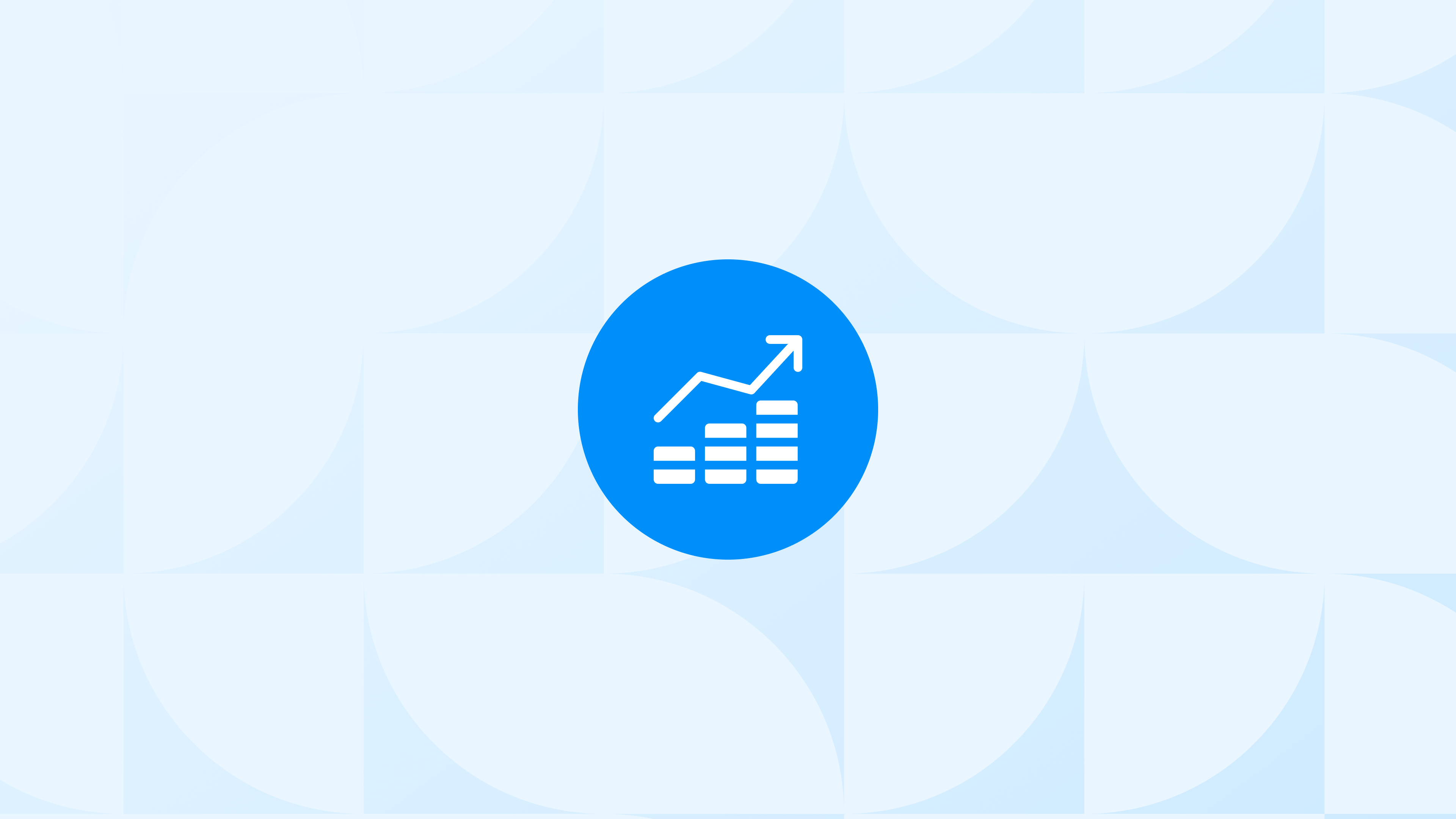It’s a common frustration for Shopify merchants. You check your Shopify sales, then open GA4 and the revenue is lower. Sometimes just a little. Sometimes significantly. That mismatch affects how you evaluate performance and allocate ad spend.
The problem isn’t a bug. It comes from a mix of tracking limitations, browser behaviors, privacy restrictions, and platform-specific gaps. In this article, we’ll break down the most common reasons GA4 shows lower revenue than Shopify and explain how each one can be fixed.
For each issue, we’ll also show how Analyzify solves it through a server-side, Shopify-native tracking setup.
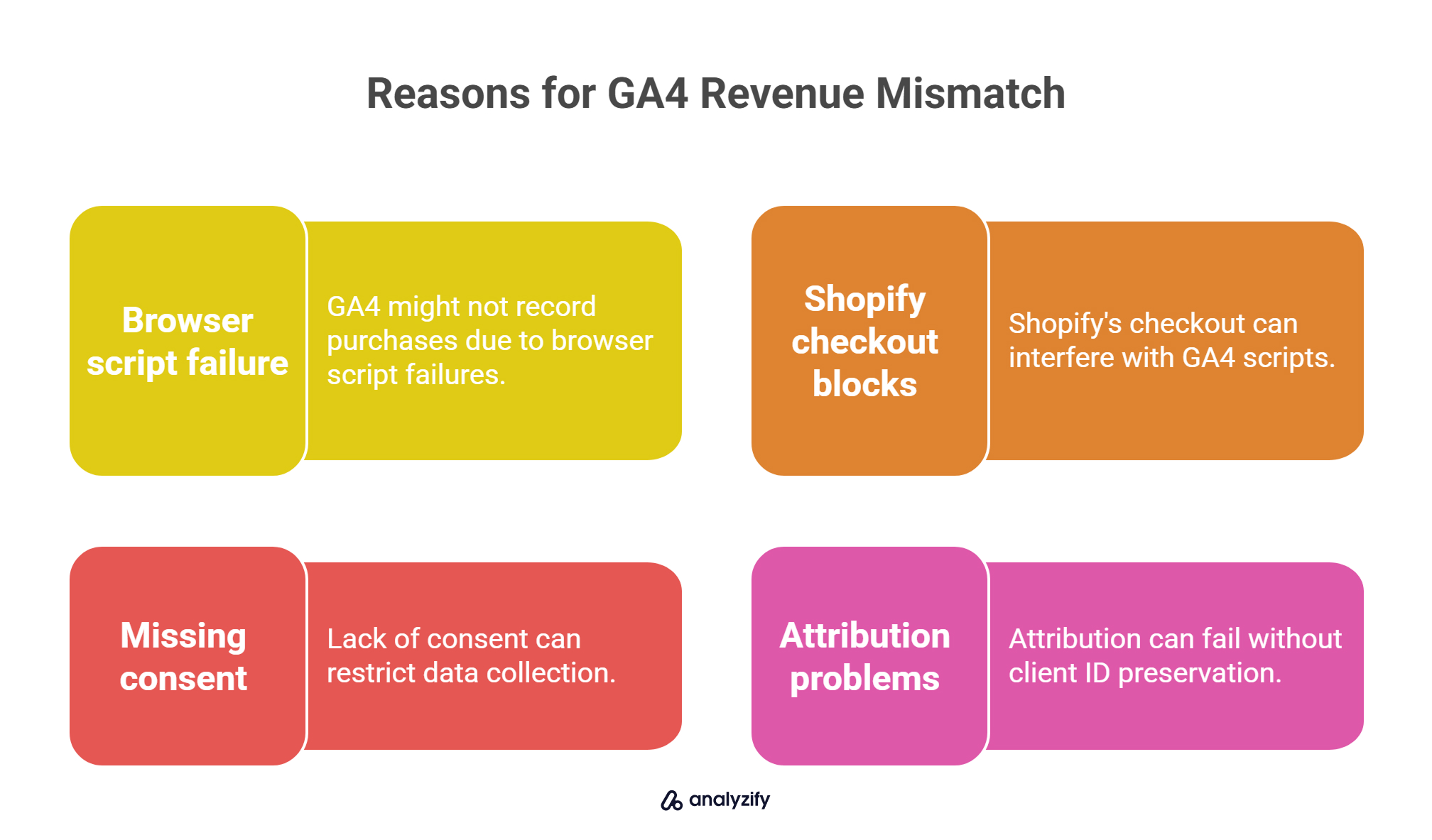
Key Takeaways:
GA4 doesn’t always receive the purchase event if browser scripts fail
Shopify’s checkout structure can block native GA4 scripts
Missing consent prevents events or limits available data
Attribution often breaks without client ID preservation
Analyzify fixes these gaps using a hybrid, server-side method designed for Shopify
Why GA4 Might Miss Purchase Events in the Browser
By default, GA4 tracks purchases using scripts that run in the customer’s browser. Most setups rely on the thank_you page to send the purchase event. But sometimes, that event never gets sent.
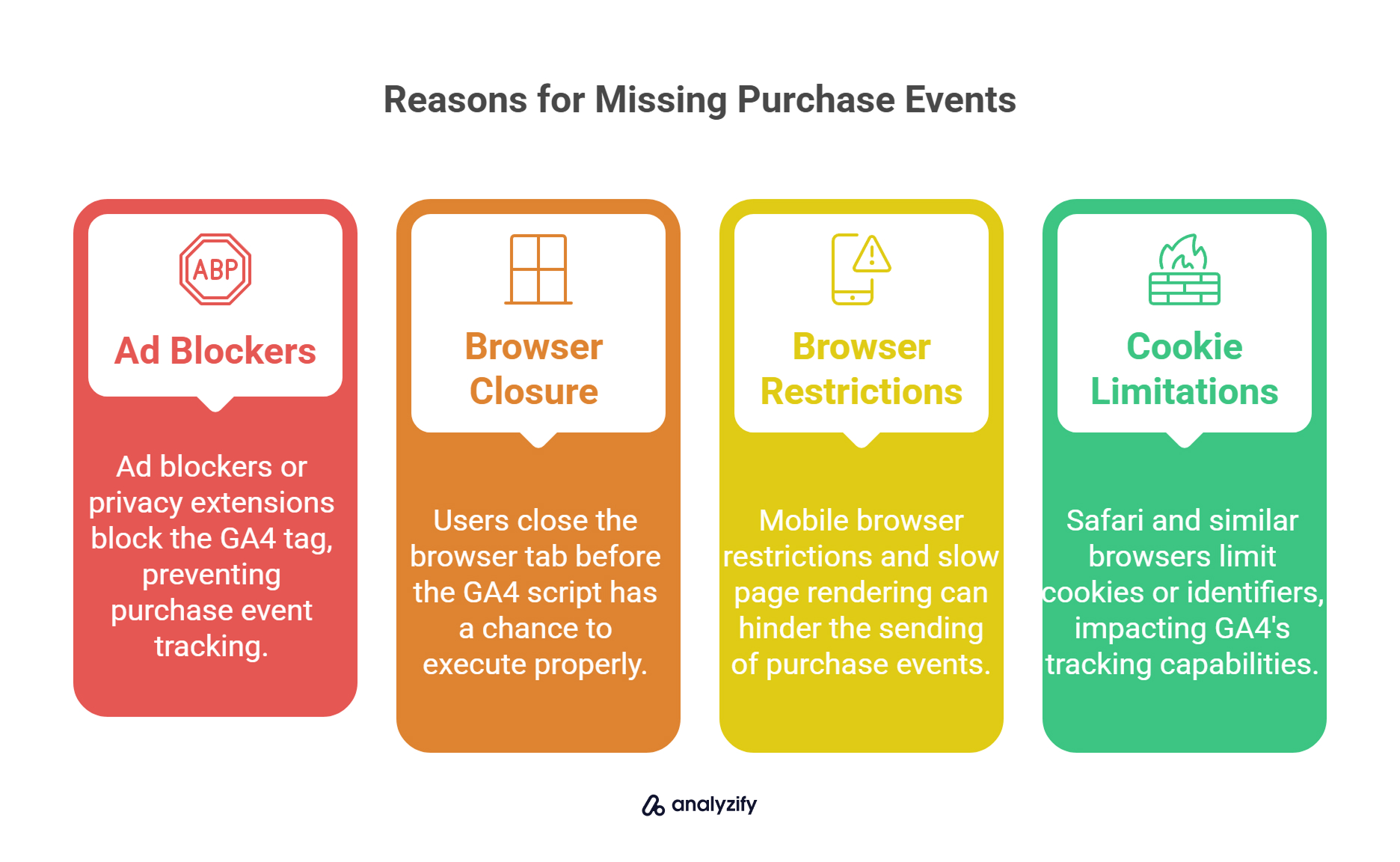
Here’s what can prevent it:
Ad blockers or privacy extensions blocking the GA4 tag
Users closing the browser tab before the script executes
Mobile browser restrictions and slow page rendering
Safari and similar browsers limiting cookies or identifiers
When this happens, GA4 never receives the event, even though the order is fully recorded in Shopify.
Over time, these missed events create a growing gap in your analytics.
How Analyzify Solves This
Analyzify includes server-side GA4 tracking that works independently from the browser. As soon as an order is confirmed, the event is sent from Shopify’s backend to GA4 using the Measurement Protocol.
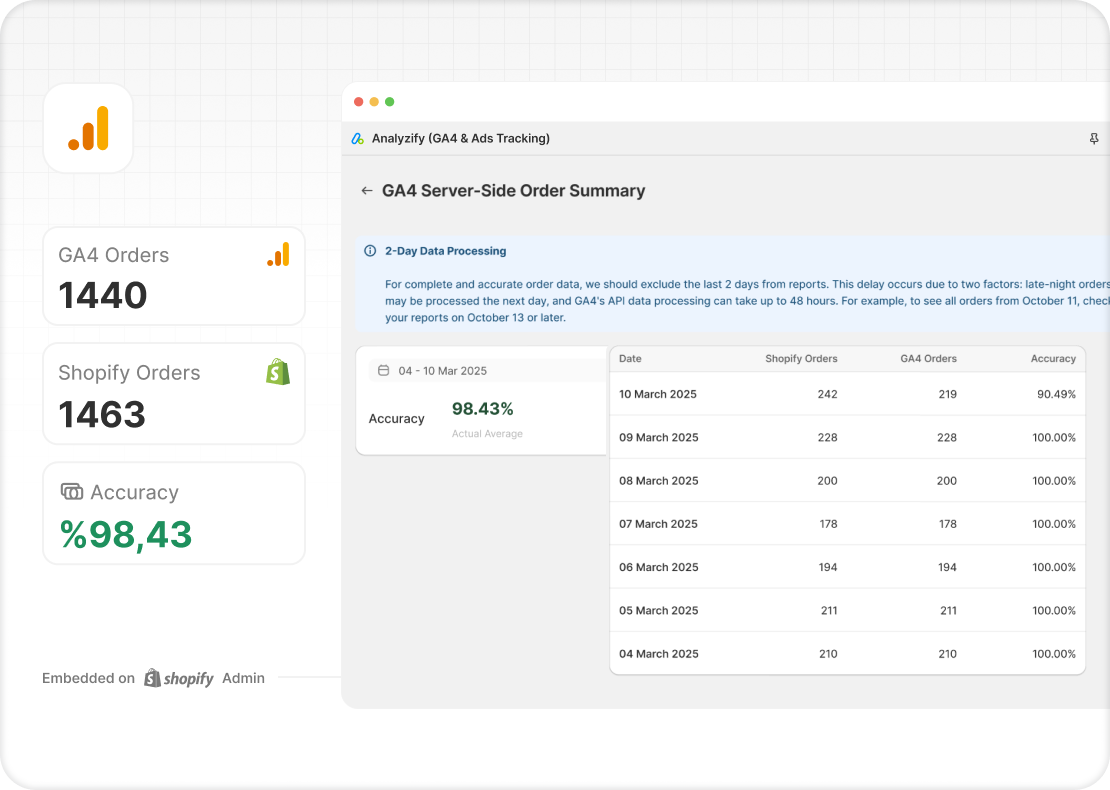
This ensures:
Every confirmed order is reported, regardless of browser behavior
GA4 receives consistent purchase values, product data, and more
Tracking remains stable even on mobile or ad-blocked sessions
This method helps close the revenue gap and provides a more reliable base for your reports.
 Built for Shopify - No Dev Work Required - Fast Setup
Built for Shopify - No Dev Work Required - Fast Setup 
Standart Tracking Methods Aren't Enough for Shopify
Let Analyzify combine client-side and server-side tracking. So you capture every important event, even when browser script fail.How Shopify Checkout Can Interrupt GA4 Purchase Tracking
Even when the browser is working normally, GA4 might still miss the purchase event, especially if it relies only on Shopify’s thank_you page.
Most native GA4 setups use the thank_you page to trigger the purchase event. But depending on how the checkout flow plays out, this page might not load or execute properly.
![]()
Here’s what can happen:
The customer closes the tab or app immediately after completing payment
External payment gateways (like PayPal or Shop Pay) may redirect users before the final page loads
Shopify Plus stores using custom checkout extensions might delay or block scripts
Some apps or themes interfere with script timing or placement
When the purchase event depends entirely on that page, even small changes or behaviors can lead to data gaps. Over time, these gaps show up as missing revenue in GA4.
How Analyzify Solves This
Analyzify tracks purchases directly from the Shopify backend using server-side methods. Instead of waiting for a page load, it sends the purchase event to GA4 the moment an order is confirmed in your store.
What this means in practice:
Orders are tracked even if the thank_you page is never seen
Checkout extensions or external gateways no longer affect data
You can trust that completed purchases show up in your GA4 reports
This is especially valuable for stores using Shopify Plus or alternative payment flows, where front-end scripts are more likely to be skipped or blocked.
Bonus: Explore our detailed guidebook on Server-Side Tracking!
Why Missing Consent Leads to Missing GA4 Revenue
If a visitor doesn’t provide the right type of consent, GA4 is not allowed to collect or process data from their session. This affects not only behavioral insights but also revenue tracking.
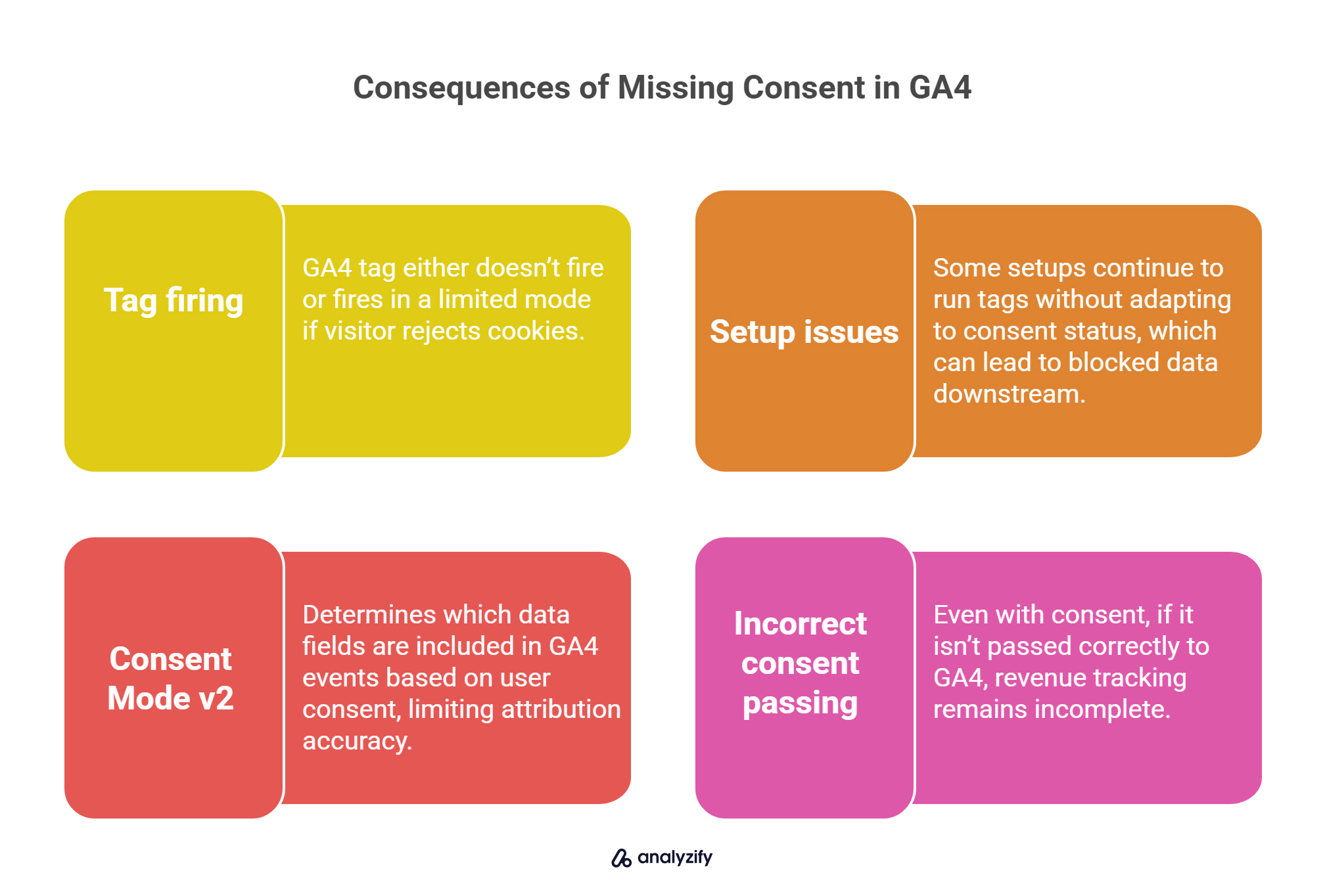
Here’s what typically happens:
If the visitor rejects marketing or analytics cookies, the GA4 tag either doesn’t fire or fires in a limited mode
Some setups continue to run tags without adapting to consent status, which can lead to blocked data downstream
Consent Mode v2 determines which data fields are included in GA4 events based on user consent. For example, if the user declines analytics cookies, GA4 might not receive the client_id, IP address, or region information — even if the event itself is still sent. This limits attribution accuracy and may cause purchases to appear as “direct” or “unassigned” in reports.
Even with consent, if it isn’t passed correctly to GA4, revenue tracking remains incomplete
This is especially problematic for merchants using third-party CMPs (consent management platforms) without proper GA4 integration.
Bonus: Learn more about Why You Need Server-Side Tracking for Shopify in 2025!
How Analyzify Solves This
Analyzify supports Shopify’s Customer Privacy API and Google Consent Mode v2 out of the box. It adapts event behavior based on consent status and ensures that your GA4 setup stays compliant while still capturing the data you’re allowed to process.
What this enables:
GA4 purchase events are sent only when legally permitted
Consent signals are respected at the browser level and passed correctly to the server
Analyzify’s fallback logic ensures that even when some data is restricted, core conversions still reach GA4 in a privacy-safe way
This makes it easier to stay compliant without losing the majority of your purchase tracking, especially for stores operating in the EU, UK, or other privacy-regulated markets.
 Shopify-Native, GDPR-Ready, Consent Mode Supported
Shopify-Native, GDPR-Ready, Consent Mode Supported 
Compliant & Clear, Consent-Based Tracking That Works
Analyzify helps you capture accurate GA4 and ad data - while fully respecting consent preferences and legal boundariesHow Client ID Loss Breaks Attribution in GA4
Even when purchase events are recorded correctly, GA4 can still misattribute them, or label them as “direct”, if it can’t connect the session to the user’s original visit. This happens when the client ID (or user ID) is lost or not carried through the full customer journey.
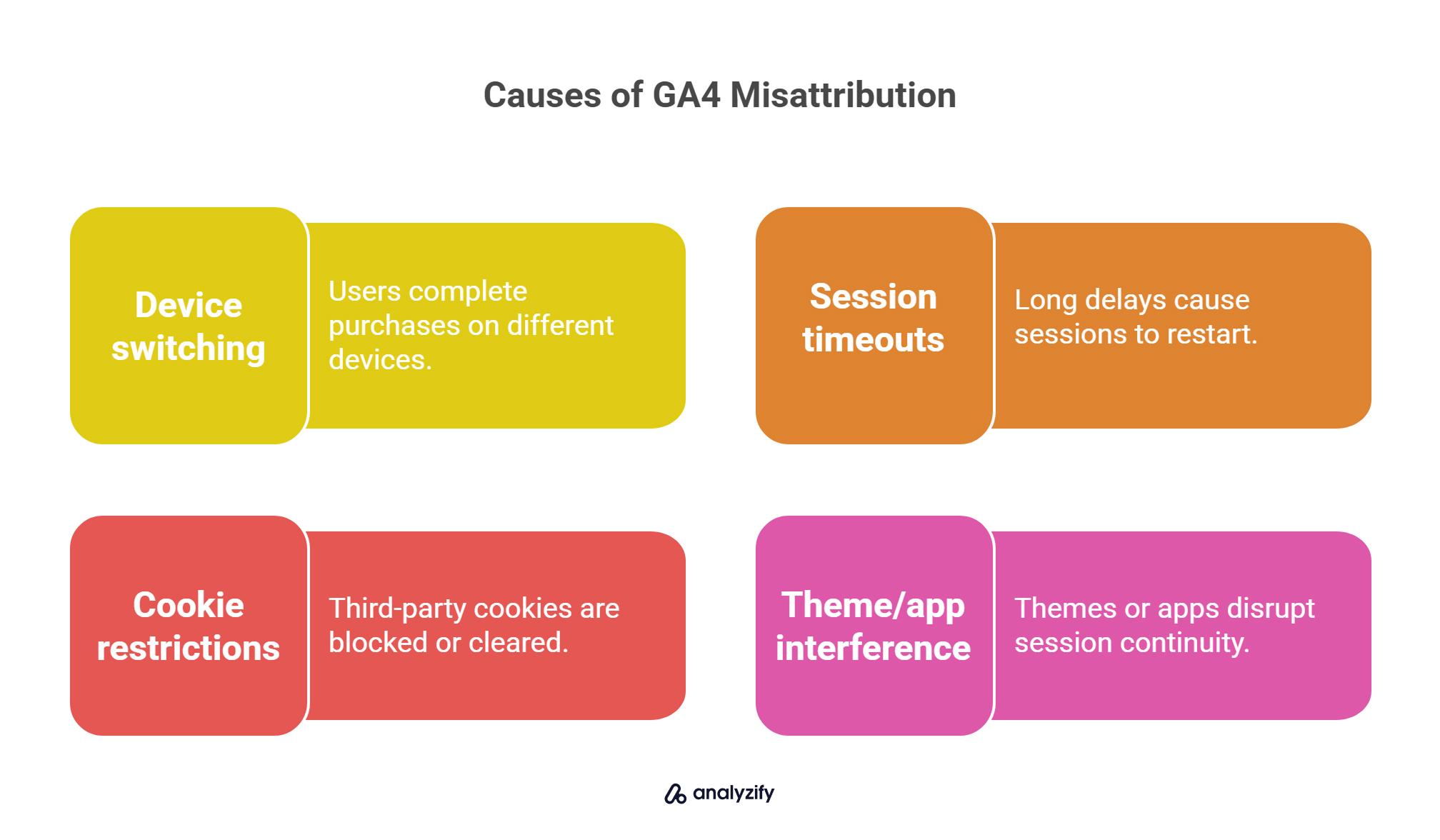
Some common causes:
Sessions time out or restart due to long delays between visits
Third-party cookies or browser resets clear stored identifiers
Certain themes or apps interrupt GA4’s ability to maintain session continuity
As a result, GA4 registers the purchase but can’t link it back to the campaign, ad, or referrer that originally drove the visit. This skews attribution models and can make high-performing campaigns look ineffective.
How Analyzify Solves This
Analyzify captures and stores user identifiers early in the session and ensures they’re included in the server-side event sent to GA4 at the time of purchase. This preserves attribution even if the browser has lost the original tracking cookie or the session has restarted.
![]()
Here’s what that delivers:
More purchases tied to the correct channel or campaign
Support for long customer journeys that span multiple sessions or devices
By protecting attribution across the entire funnel, Analyzify gives you a more accurate picture of what’s working and what’s not.
 Built for Shopify - No Dev Work Required - Fast Setup
Built for Shopify - No Dev Work Required - Fast Setup 
Your attribution data doesn't match across platforms.
Let Analyzify bridge the gap between Shopify, GA4, and ad platforms - with clean data and quick setupWhy GA4 Might Miss Key Order Details
Even when GA4 successfully records a purchase, the data it receives might be incomplete. Many native or basic GA4 setups only send the bare minimum: order value, product name, and currency. But other important details are missing.
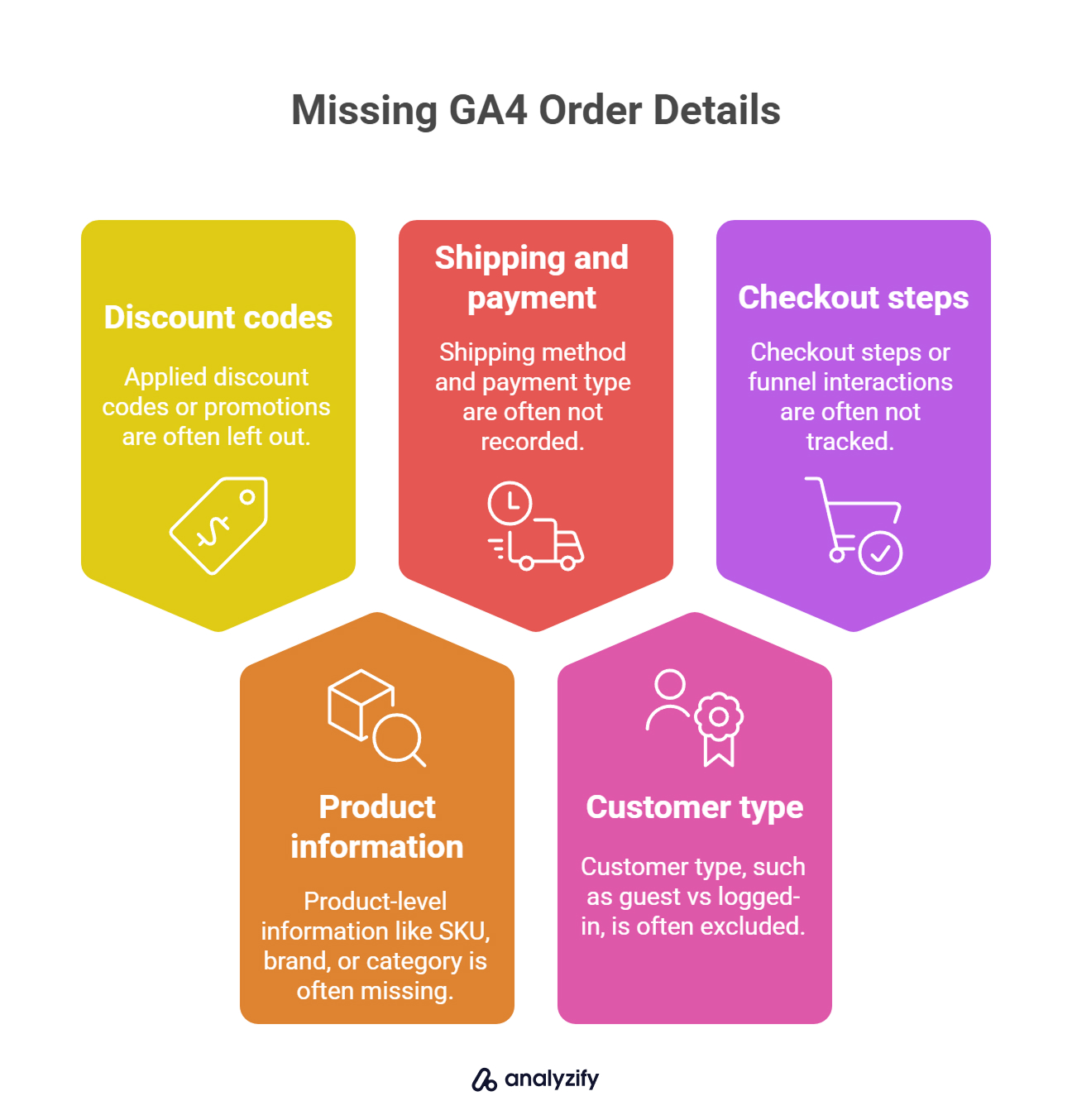
What’s often left out:
Applied discount codes or promotions
Product-level information like SKU, brand, or category
Shipping method and payment type
Customer type (guest vs logged-in)
Checkout steps or funnel interactions
These gaps limit your ability to analyze performance across product types, customer segments, and promotions. They also weaken retargeting, reporting, and revenue attribution within GA4.
How Analyzify Solves This
Analyzify enriches the purchase event with complete order data pulled directly from Shopify. It builds a structured server-side payload that includes all relevant transaction details and passes them to GA4 using Measurement Protocol.
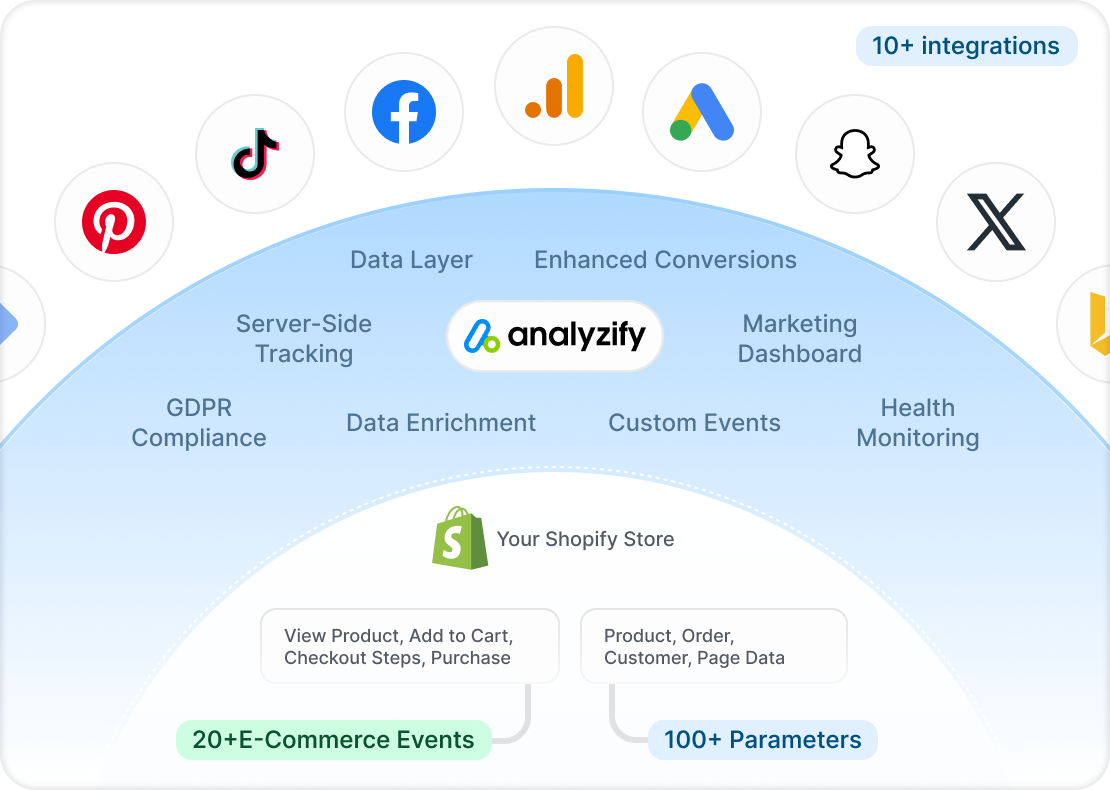
Here’s what’s included:
Full product metadata, including variant ID, SKU, and collection
Applied discount codes, coupon values, and cart-level changes
Checkout behavior and payment method insights
Optional support for custom dimensions if needed
In this way, you can segment and report meaningfully in GA4, without relying on manual tagging or post-processing.
 Built for Shopify - No Dev Work Required - Fast Setup
Built for Shopify - No Dev Work Required - Fast Setup 
Missing Conversions in GA4 or Meta Ads?
Standart browsing tracking misses conversions - Analyzify adds Server-side tracking for accurate GA4 & Meta reports.How Session and UTM Data Gaps Affect GA4 Revenue Accuracy
Sometimes GA4 records a purchase event correctly, but the source of that purchase appears as “direct”, even when the user clearly came from an ad or a campaign. This happens when session data or UTM parameters are lost somewhere along the journey.
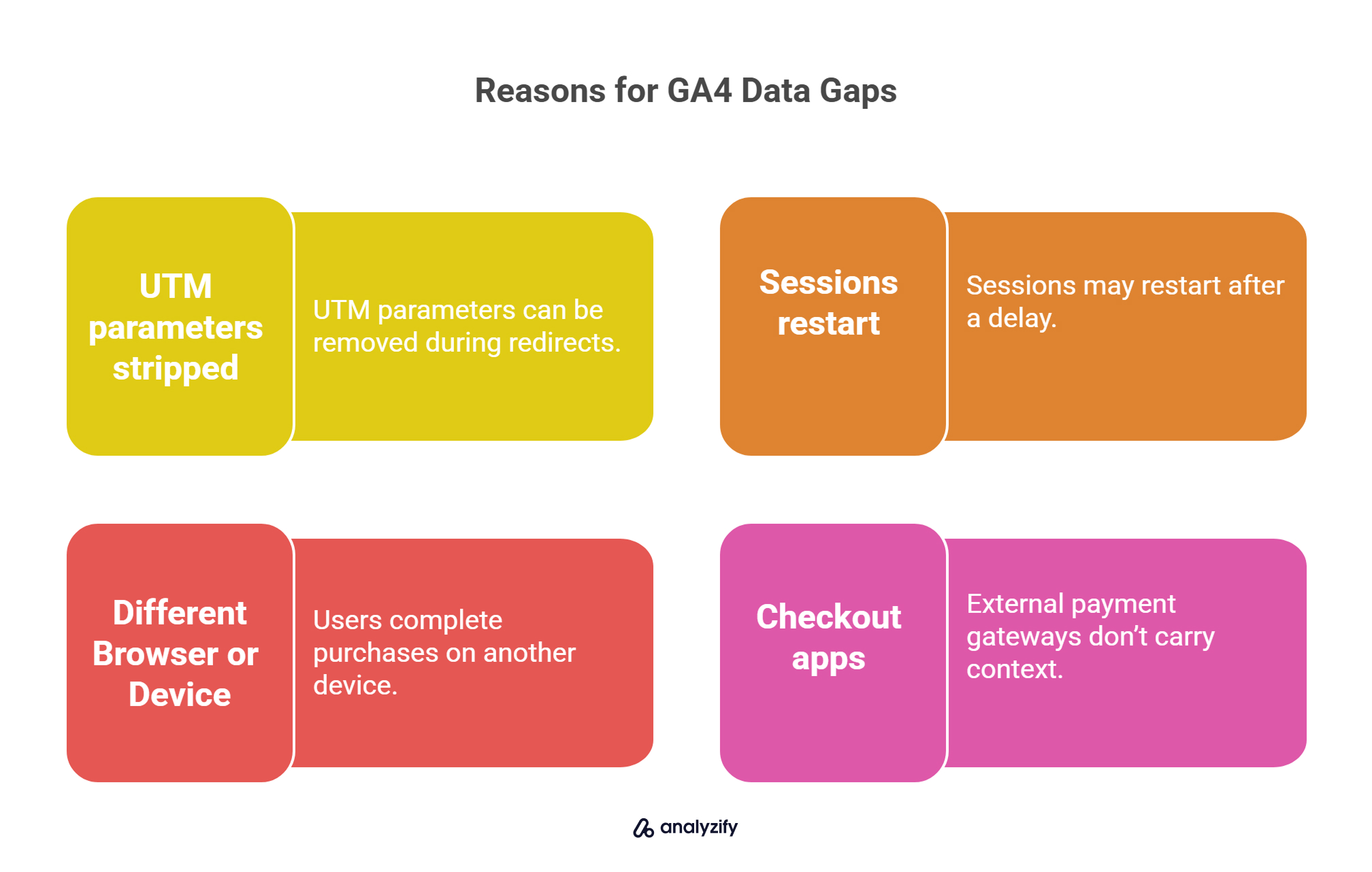
Some reasons this occurs:
UTM parameters are stripped during redirects or app transitions
Sessions restart after a delay or due to inactivity
Users return to complete their purchase through a different browser or device
Checkout apps or external payment gateways don’t carry session context
Use of GA4’s data-driven model
The end result is that GA4 sees the revenue but can’t credit the right channel. This affects your attribution accuracy and can lead to underreporting for paid campaigns or organic performance.
How Analyzify Solves This
Analyzify preserves both session and UTM data. It collects campaign parameters on the client side and stores them until the server-side purchase event is ready to be sent. When the event is triggered from Shopify’s backend, the original UTM and session context is included.
Here’s what that improves:
Additional alignment between GA4 revenue and campaign source
Reduced number of “direct” or “unassigned” conversions
Attribution reporting across multiple touchpoints
By keeping session context intact across the full journey, Analyzify helps GA4 reflect the real source of your sales — not just the last browser state.
Bonus: Discover the key differences between Analyzify and Native Shopify GA4 Integration.
Can GA4 and Shopify Revenue Ever Fully Match?
In short, not exactly. Even with a perfect setup, you’ll almost always see a small difference between GA4 and Shopify revenue. That doesn’t mean something is broken. It simply reflects how tracking systems work.
![]()
GA4 and Shopify measure revenue in different ways:
Shopify records every confirmed order, including returns, taxes, and adjustments
GA4 only captures what it’s allowed to track, based on browser behavior, consent, and technical delivery
Differences in time zones, refund timing, or multi-device behavior can create minor variations
In well-configured setups, it’s common to see alignment in the 95% to 98% range and that’s considered healthy by most advanced analytics teams.
How Analyzify Helps You Reach That Level
Analyzify is built to get your GA4 revenue as close as possible to your Shopify backend. By combining client-side and server-side tracking, it ensures that purchases are recorded even when browser scripts fail or data is limited.
Here’s how it supports better alignment:
Captures every confirmed order directly from Shopify’s backend
Preserves session, UTM, and attribution data from start to finish
Enriches events with full order details and optional custom fields
Handles Consent Mode and privacy settings with precision
The result is a cleaner, more reliable GA4 dataset giving you confidence in your revenue reports, even if a small gap remains.
Achieve Data Confidence and Get the Help You Need When It Matters.
Final Recommendations: Closing the GA4-Shopify Gap
If your GA4 revenue doesn’t match Shopify it’s not a reason to abandon GA4. But it is a reason to improve your tracking setup.
Each issue we’ve covered contributes a piece of the puzzle. Together, they explain why GA4 might underreport revenue and how merchants can improve alignment without sacrificing data privacy or performance.
![]()
To get the most accurate GA4 revenue tracking on Shopify:
Use a hybrid tracking model that combines client-side and server-side events
Ensure that order data, UTM parameters, and session context are preserved
Adapt your setup to comply with GDPR and Consent Mode v2
Avoid relying solely on the thank_you page or default pixel integrations
Choose a solution that’s built for Shopify’s unique architecture and checkout flow
Analyzify brings all of this into one complete tracking setup with no-code server-side implementation, fully integrated GA4 support, and Shopify-native logic.
If you’re serious about accurate revenue tracking, now is the time to upgrade your setup.Explore Analyzify’s GA4 server-side solution and get your tracking where it should be.
 Built for Shopify - No Dev Work Required - Fast Setup
Built for Shopify - No Dev Work Required - Fast Setup 
Start Tracking Shopify Orders Accurately!
Let Analyzify's enhanced server-side tracking provide you with more accurate & reliable attribution data - setup in 10-15 minutes.






























